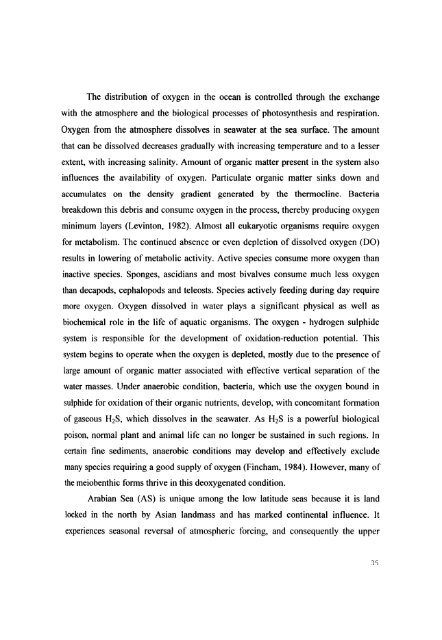L - Cochin University of Science and Technology
L - Cochin University of Science and Technology
L - Cochin University of Science and Technology
You also want an ePaper? Increase the reach of your titles
YUMPU automatically turns print PDFs into web optimized ePapers that Google loves.
The distribution <strong>of</strong> oxygen in the ocean is controlled through the exchange<br />
with the atmosphere <strong>and</strong> the bioiogical processes <strong>of</strong> photosynthesis <strong>and</strong> respiration.<br />
Oxygen from the atmosphere dissolves in seawater at the sea surface. The amount<br />
that can be dissolved decreases gradually with increasing temperature <strong>and</strong> to a lesser<br />
extent, with increasing salinity. Amount <strong>of</strong> organic matter present in the system also<br />
influences the availability <strong>of</strong> oxygen. Particulate organic matter sinks down <strong>and</strong><br />
accumulates on the density gradient generated by the thermocline. Bacteria<br />
breakdown this debris <strong>and</strong> consume oxygen in the process, thereby producing oxygen<br />
minimum layers (Levinton, 1982). Almost all eUkaryotic organisms require oxygen<br />
for metabolism. The continued absence or even depletion <strong>of</strong> dissolved oxygen (DO)<br />
results in lowering <strong>of</strong> metabolic activity. Active species consume more oxygen than<br />
inactive species. Sponges, ascidians <strong>and</strong> most bivalves consume much less oxygen<br />
than decapods, cephalopods <strong>and</strong> teleosts. Species actively feeding during day require<br />
more oxygen. Oxygen dissolved in water plays a significant physical as well as<br />
biochemical role in the life <strong>of</strong> aquatic organisms. The oxygen - hydrogen sulphide<br />
system is responsible for the development <strong>of</strong> oxidation-reduction potential. This<br />
system begins to operate when the oxygen is depleted, mostly due to the presence <strong>of</strong><br />
large amount <strong>of</strong> organic matter associated with effective vertical separation <strong>of</strong> the<br />
water masses. Under anaerobic condition, bacteria, which use the oxygen bound in<br />
sulphide for oxidation <strong>of</strong> their organic nutrients, develop, with concomitant formation<br />
<strong>of</strong> gaseous H2S, which dissolves in the seawater. As H2S is a powerful biological<br />
poison, normal plant <strong>and</strong> animal life can no longer be sustained in such regions. In<br />
certain fine sediments, anaerobic conditions may develop <strong>and</strong> effectively exclude<br />
many species requiring a good supply <strong>of</strong> oxygen (Fincham, 1984). However, many <strong>of</strong><br />
the meiobenthic forms thrive in this deoxygenated condition.<br />
Arabian Sea (AS) is unique among the low latitude seas because it is l<strong>and</strong><br />
locked in the north by Asian l<strong>and</strong>mass <strong>and</strong> has marked continental influence. It<br />
experiences seasonal reversal <strong>of</strong> atmospheric forcing, <strong>and</strong> consequently the upper<br />
35

















